 After a trip to the library, I was inspired by the book Chameleons are Cool illustrated by Sue Shields. I love her use of color and large shapes plus the abundance of watercolor techniques on each page. If I had a color printer at school, I'd photocopy a page and hand a sheet to every student, just so they could be inspired by the wet-on-wet techniques, the wet-on-dry techniques and the splatters!
After a trip to the library, I was inspired by the book Chameleons are Cool illustrated by Sue Shields. I love her use of color and large shapes plus the abundance of watercolor techniques on each page. If I had a color printer at school, I'd photocopy a page and hand a sheet to every student, just so they could be inspired by the wet-on-wet techniques, the wet-on-dry techniques and the splatters!
Instructions:
1. Pencil Drawing
I demonstrate strategies for drawing the chameleon, looking at shapes and position on page to ultimately create the outline. I encourage the kids to make teh subject large, but of course, some students insist on making them small. No problem but we all know it's easier to paint larger items!
2.Outline pencil lines with indelible black marker.
This takes some time so stress that very little detail be placed inside the outline of the chameleon. Details will come with the watercolor techniques.
Tip: If doing this lesson with younger grades, try using an oil pastel to create the chameleon. Skip the pencil and pen step and have the children draw a large chameleon.
3. Watercolors!
For each table, I set out a tray of liquid watercolors, a small cup of rubbing alcohol and a small cup of salt.
For the watercolor demonstration, I have the children gather around a table, instead of watching on the board, as the results are so much better up close.
Wet-on-wet: I show the kids how to paint one color, then while the paint is still wet, add another on top to blend.
Wet-on-dry: Since this lessons takes 2-3 classes, once one section of the chameleon is dry, they can then paint over that section to create spots, stripes, dots, etc.
Rubbing alcohol: While the paint is wet, drop some RA onto different sections to create a "scaly" or "rubbery" texture.
Salt: While paint is wet, sprinkle some salt to create small twinkles of star-like dots.
Splatter paint: using a brush loaded with color, run your fingers along the bristle to create large and small splatters.
The results of this project was spectacular. If and when I do this again, I'd recommend that the kids not put in any background details. I think the chameleon can hold it's own!
(The art shown here is from Mr. Ranson's class at Mountain View School)







For more watercolor lesson ideas, check out Deep Space Sparkle's "Watercolor Projects" PDF booklet. Click HERE for more details. To purchase, click on the Google Checkout button below.

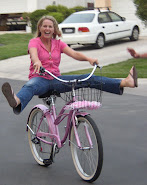






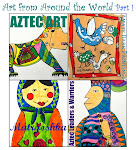
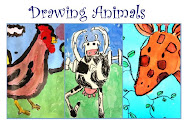
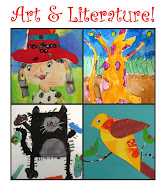

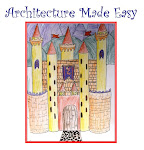
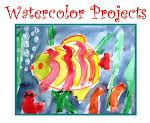





7 comments:
I just found your blog. I am an art teacher at an inner city school in Memphis. I am going to ambitiously try to use some of the lessons. this is only my second year and the kids have never had art before so I may have to modify it.
I have trouble painting with wet paint because the paper wrinkles so much. any suggestions? what kind of paper do you use?
also, i only have cake watercolors and have never bought liquide watercolors. are they better?
thanks,
Lori
Hi Lori,
I'm so glad you found me! Congratulations on your second year of teaching art. It can be overwhelming at first, trying new projects and hoping they "turn out". I know I made a ton of boo-boo's but just passed it up as a fun experience.
Here are a few suggestions: Instead of drawing a detailed chameleon with a waterproof marker, try oil pastels. This will encourage the kids to draw on a larger scale (better for lower grade levels). Also, I'd really recommend purchasing liquid watercolors. They are perfect for this type of project as all the kids have to do is dip their paint brush into the color and instantly, they have a perfectly saturated paint. It is so vibrant and blends really well. You can find the paint through any of the art catalogs I listed on my blog. Using cake watercolor works equally well, but I've become a huge fan of the liquids. As a cheaper resource, try food coloring. Buy in bulk at places like Smart and Final.
Also, I'd use any cheap watercolor paper with this lesson. Regular Sulphite construction paper absorbs too much of the paint, making blending difficult. Although, construction paper is what I use for ALL of my other painting lessons. You can find this paper in the art catalogs as well.(Cheap!)
Good luck!
Hello, I teach in Calgary, Alberta. One of the tricks I use for working with water colour paint is a great one. See if you can find a bunch of those plastic, corregated signs used by politicians. Cut them so they are bigger than the paper you use a lot. Mine are 12 by 18. Using masking tape, tape your paper down. Teach the kids how to tape them so the borders are even. have the kids do their paintings,then let them dry, usually overnight. Carefully peel off the tape and you are left with a lovely painting that has a great white border all the way around. Because the boards are plastic, they don't warp and if they get covered in paint they wash easily.
Heather
Thanks Heather! Thats a great tip.
We just did a lesson inspired by this, and it was a hit. Thanks again for sharing.
How do you dispense liquid watercolors to young children so clean up is quick and easy? Any other suggestions when working with this medium? I'm very interest in ordering these for my classes!
Liquid watercolors by their very nature are extremely easy to clean up. I put mine in a 6-well plastic palette and after the kids are done, I simple run under water.
Last year I began saving the watercolors in small plastic "Salsa" cups with lids. I still use the 6-well palette, but just set the plastic cups in the wells. When the class is over, simple pop on a lid and store.
This seems only to be effective with older kids as they rinse their brushes better than the younger kids.
My advice to you is order the product and experiment You'll get a great sense for the product once you have it.
Post a Comment